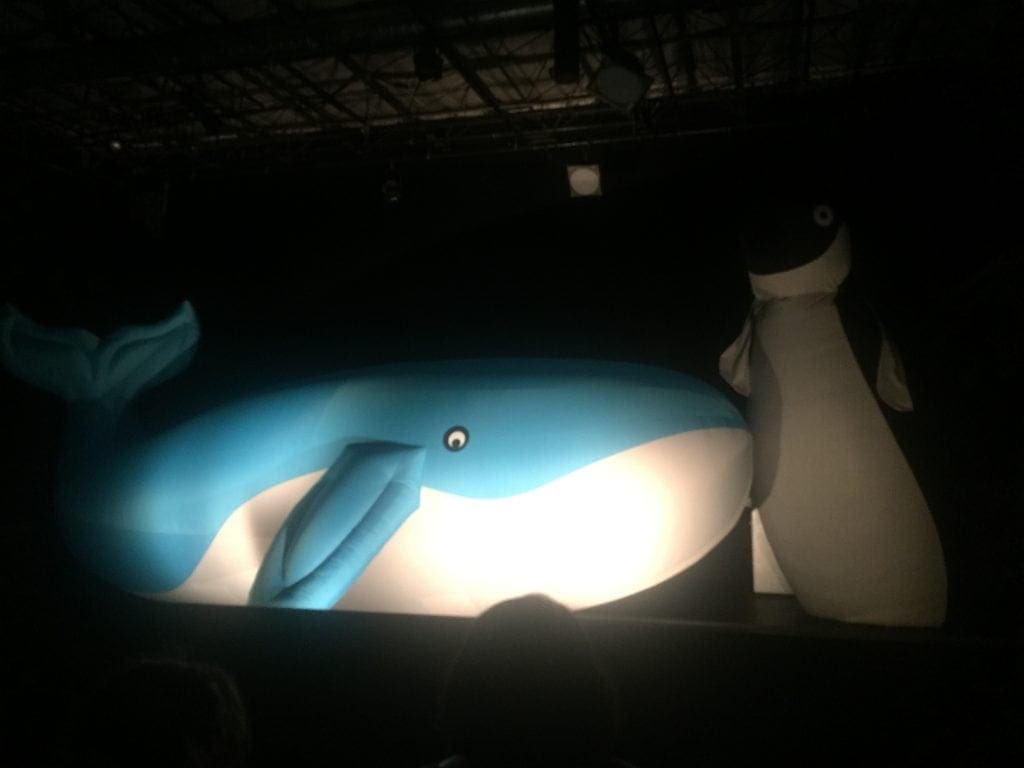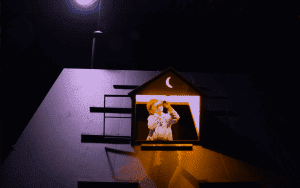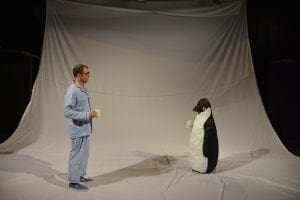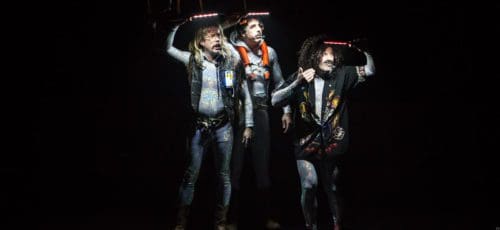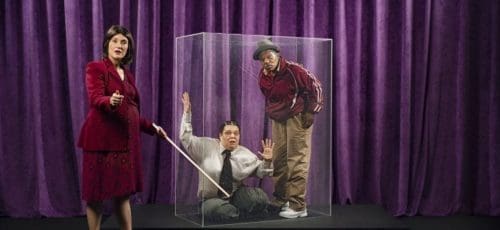A Good Balance of Comfort and Discomfort: An Interview with Steven Dufala
This week, two Philly Fringe favorites are returning to the Festival with two very different shows. Absurdist theater artist Geoff Sobelle will mount HOME on September 13, an ambitious new piece that ruminates on the transitory nature of dwelling, the impossible structural demands of a house, and the absurdity of making a home. Meanwhile, on September 14, theater maker and performer Thaddeus Phillips will premiere his latest work, A Billion Nights on Earth, a fantastical show for all ages that dives into the realms of parent–child relationships, as pair stumble through alternate realities in search of a beloved stuff whale. Though both of these shows are starkly different, they do have one thing in common. That would be artist Steven Dufala.
Dufala has been creating work in a variety of media for decades now. He has regularly collaborated with his brother Billy, under the name The Dufala Brothers, and together their work—often humorous, hyperbolic reimaginings of everyday or iconic items—has been exhibited widely. They’ve also organized absurdist artistic happenings, including a toilet-trike race through Old City during the 2005 Fringe Festival.
Recently, Steven Dufala has lent his exceptional talents to some ambitious works of theater, designing sets and making some larger than life visions a reality. Perhaps most notable among these collaborations was his work on Geoff Sobelle’s widely lauded show The Object Lesson, which had its premiere during the 2013 Fringe Festival and has since been taken all over the world. Turning theaters into storage spaces with boxes stacked high to the ceiling and filled with the usual household wares, the kind of miscellanea that does little but collect dust but somehow stays with you for years, as well as some more surreal keepsakes—”moss to mystic” designated actual moss with a strong whiff of incense, “acorn collection” ought to be self explanatory—his design and installation work on the show was critical to achieving its uncanny yet strikingly down to earth vibe.
We recently caught up with Dufala to learn more about his artistic practice and what it’s been like splitting his time between these two aesthetically divergent shows.
FringeArts: Tell us a bit about your background.
Steven Dufala: I grew up in south Jersey, the middle of five boys in a creative household. Our parents were pianists and teachers, and all the brothers make things. So I’ve always been making things.
FringeArts: What was the Philadelphia arts community (or communities) like when you first arrived at the Pennsylvania Academy of Fine Arts?
Steven Dufala: I used to like to say the scene was mostly living rooms and basements, and I guess that’s still kind of true, but everything was really DIY. Pig Iron was making shows in basements, the best music was at peoples houses, the best parties, the best art shows didn’t really look like shows, but were kind of one or two night show/parties. Old City was kind of too fancy, and no one really went north of Spring Garden.
When I got to Philly, I didn’t go straight to the academy, I was at UArts for two years in film and animation. That basically cracked open a whole world of creativity I’d never really explored and that’s why I went to PAFA—to try and get a better foundation for making things in general.
FringeArts: You’ve been working closely with your brother Billy for decades now. How would you characterize your creative partnership?
Steven Dufala: This is always the tough one to explain. We collaborate in every way you could think applicable using that term.
It’s not always about the things we make, but as brothers we are pretty much up in each others’ business all the time. So we are sounding boards, moral support, critics, and go-to guys for each other on any number of topics. For us, it’s mostly about the life we’re making for ourselves and each other. Whatever that may mean. We’ve recently been giving each other a little space, he’s got RAIR, and I’ve been doing this theater stuff, but we’re still very close, and are about to set up a new studio which is exciting.
FringeArts: Works of visual art credited to The Dufala Brothers often possess a satirical sensibility, critiquing our culture of excess. Has your interest in and approach to this topic changed over the course of your career?
Steven Dufala: Here I want to be careful—while we’re both into this type of critique, and are definitely watching the landscape, it’s always been about humor with this critique. And there is a difference in approach between Billy and me. He likes to go right for it, and I like to tease it out. It’s the same dynamic when we talk, a kind of straight man/funny man thing.
There’s something to getting an audience to see, or hear you that can be impossible without an “in,” for which we’ve always turned to humor. It can make difficult things palatable, and open a conversation instead of wagging a finger, which we both dislike. No one especially likes being told what to do or what to think, so it’s tricky to crack some of this open.
We also don’t come down squarely on a lot things, as most of the conversations around consumption are really fraught, and have lots of sides. Even if we’re making what we see as a one-liner, we try and be careful to leave it open just enough. We’re not activists, we’re artists.
Currently, I find myself drifting from more hot-button issues, especially in light of the sheer volume of voices trying to wrestle with our current political climate. It’s kind of too much for me, and because I’ve been spending a lot of time making theater, when I’ve got a minute to draw in the studio, the last thing I’m thinking about is critique. There are things to lampoon other than global and national issues. Regular people are still doing really dumb things every day.
FringeArts: Can you describe the set you’ve created for A Billion Night’s on Earth?
 Steven Dufala: Well, to be clear, I didn’t create the set, it was collaborative. This was a really open process with both me and Thaddeus sharing the responsibility and it took a lot of other minds to get where we’ve ended up. I’d wanted to work with Thaddeus for a long time, and initially design led the process for the whole show. We thought up scenes and cool tricks and images we wanted to use, and started to find a story in there. We didn’t get everything in a room until quite late in the process, and even then we were still tweaking and fussing and creating.
Steven Dufala: Well, to be clear, I didn’t create the set, it was collaborative. This was a really open process with both me and Thaddeus sharing the responsibility and it took a lot of other minds to get where we’ve ended up. I’d wanted to work with Thaddeus for a long time, and initially design led the process for the whole show. We thought up scenes and cool tricks and images we wanted to use, and started to find a story in there. We didn’t get everything in a room until quite late in the process, and even then we were still tweaking and fussing and creating.
The set itself has a couple different elements. We looked a lot of Kabuki, mostly for techniques they use, like extra people who operate things (and everyone agrees kind of “aren’t there”) and simple, almost pop-up book style staging. The engineering was Efren Delgadillo, and a lot of that was directed by Thaddeus. This gave me time to really think about the objects in the show, and how we wanted to treat what of the world we reveal, and what it should look like.
FringeArts: In our interview with Thaddeus Phillips he mentioned he treated your collaboration as one between a theater maker and an artist, rather than a set designer. How has this dynamic changed your approach compared other scenic design jobs?
Steven Dufala: Most simply, it kept things functionally close to my studio practice, which is really thinking, sketching, and making. The more I’m doing theater, the less I’m able to actually make things, for a number of reasons, and even if I do, there is precious little time in the room, with the team, to do that and get everything else done that needs to happen—you know, like the theater part of theater. It’s actually really difficult to make time to use your hands and play and experiment.
FringeArts: Can you describe the set you’ve created for HOME?
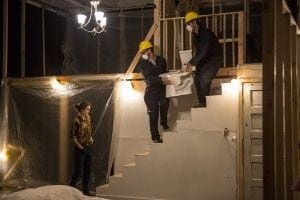 Steven Dufala: It’s a house. The ambition was to make something that could be responsive to the work Geoff was trying to create, move and change with the action, and be both sympathetic and frustrating to the performers like a real house can be. All the charms and flaws. The design evolved pretty organically, over a number of workshops, and I tried to be really patient looking for the clues that would tell me what the house wanted and needed to be.
Steven Dufala: It’s a house. The ambition was to make something that could be responsive to the work Geoff was trying to create, move and change with the action, and be both sympathetic and frustrating to the performers like a real house can be. All the charms and flaws. The design evolved pretty organically, over a number of workshops, and I tried to be really patient looking for the clues that would tell me what the house wanted and needed to be.
FringeArts: What did designing this house that could be easily reconstructed and deconstructed with each performance force you to consider?
Steven Dufala: It forced me to consider whether I actually like doing this kind of work! Ha! Kidding.
I felt a good balance of comfort and discomfort. I like taking risks and putting myself in a position to do something I don’t already know how to do. So I took the ride.
I’ve never worked toward a show on this scale. Just getting people to be able to see things from hundreds of feet away was a whole new mountain to climb. A traditional stage, fly systems, all of this was new for me. And then there was the actual thing to make. I was super lucky to have Chris Swetcky as our technical director, he was the real genius who took crazy ideas and made them mechanically possible…. and safe.
FringeArts: Did you, or anyone else on the creative team, bring anything personal to the design of the set?
Steven Dufala: Everyone did every day. Ironically, almost everyone working on the show was without a permanent home at some point during the process. Designers, performers, producers. So I think we all kind of found HOME a nice place to put that latent energy. I certainly did. Just as we were gearing up for some intense workshop time, I moved out of my studio of 15 years. So there are also some objects and furniture of mine in the house. Some doors, miscellaneous stuff.
 But really just by how the show was built. Rehearsal also steered how the house evolved in design. I think we made at least three versions of a house before we got to the final one. I tried my best to not make it a top-down thing, instead opting to watch and adapt a structure that could support the ambition of the work. Every house is a collection of rooms, but for our house I needed to know what kind of rooms, where they are in the layout, what is happening in them, what has already happened. This is where I leaned heavily on the rehearsal and writing process as a guide. It’s vital that these decisions aren’t made in a vacuum.
But really just by how the show was built. Rehearsal also steered how the house evolved in design. I think we made at least three versions of a house before we got to the final one. I tried my best to not make it a top-down thing, instead opting to watch and adapt a structure that could support the ambition of the work. Every house is a collection of rooms, but for our house I needed to know what kind of rooms, where they are in the layout, what is happening in them, what has already happened. This is where I leaned heavily on the rehearsal and writing process as a guide. It’s vital that these decisions aren’t made in a vacuum.
FringeArts: What’s been your experience working on these two very aesthetically different shows simultaneously?
Steven Dufala: I promise to never do it again. And I promise to try my best to not break that promise. But I probably will. If I do, I need to find a better balance between the designer vs. artist split. I like to be in the room, I like to get my hands dirty, but to do that with theater where there is such an intense development process, I need to better balance my own work in the studio with work for other people. So while I feel good about the work we’ve made, and super lucky to have been a part of it, I do miss my studio, and feel like I’ve been away for a year at the expense of my own practice. So I’ve got to figure out a better balance.
A Billion Nights on Earth
Thaddeus Phillips + Steven Dufala
FringeArts
140 N. Columbus Boulevard
Sept 14-17
$29 (general)
$20.30 (member)
$15 (student + 25-and-under)
| | | | | | | | | | | | | | | |
HOME
Geoff Sobelle
Prince Theater
1412 Chestnut Street
Sept 13-16
$35 (general)
$24.50 (member)
$15 (student + 25-and-under)
Interview and intro by Hugh Wilikofsky. HOME photos by Maria Baranova.

